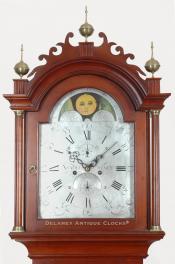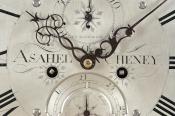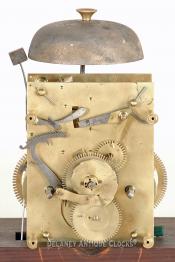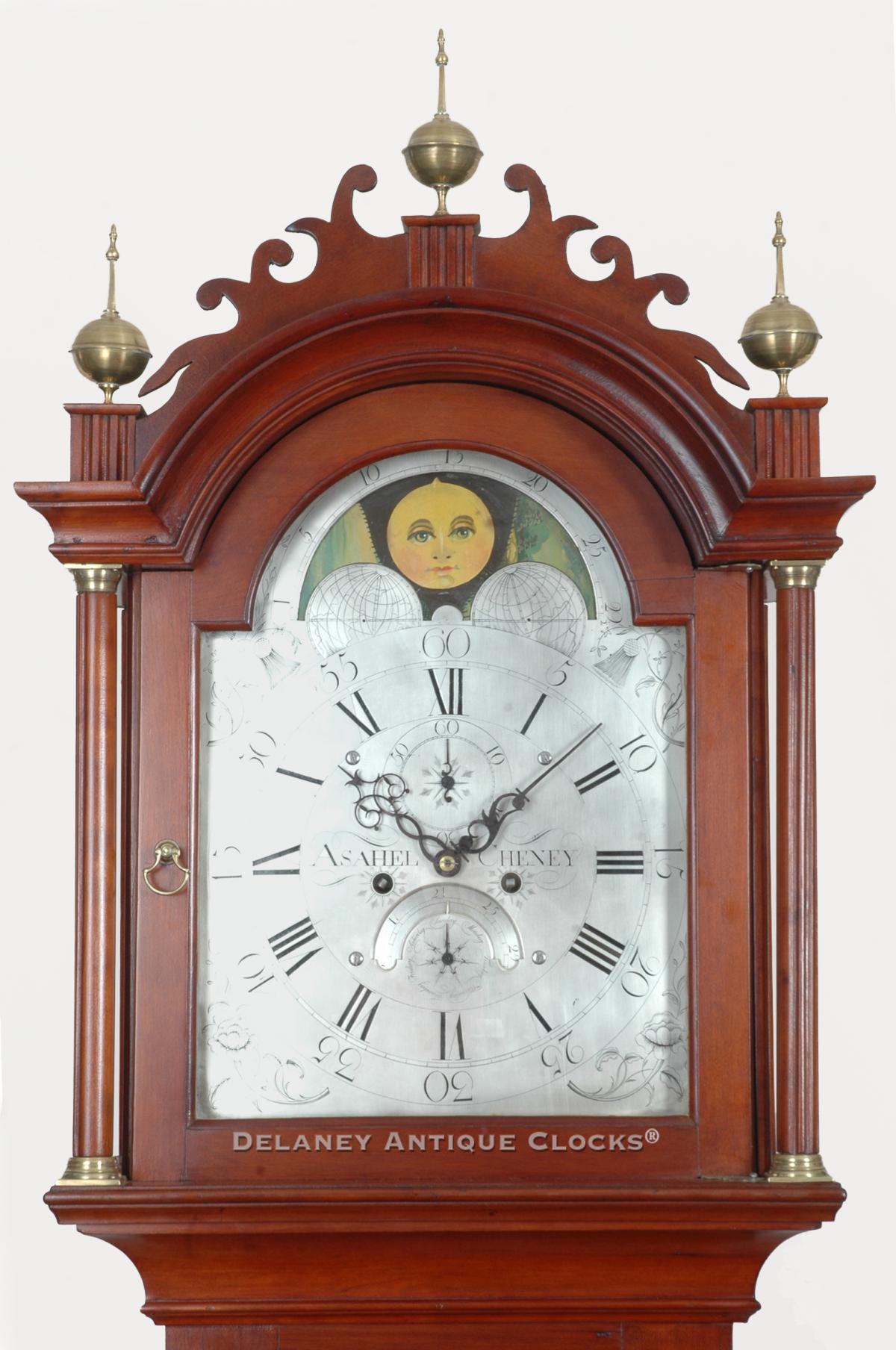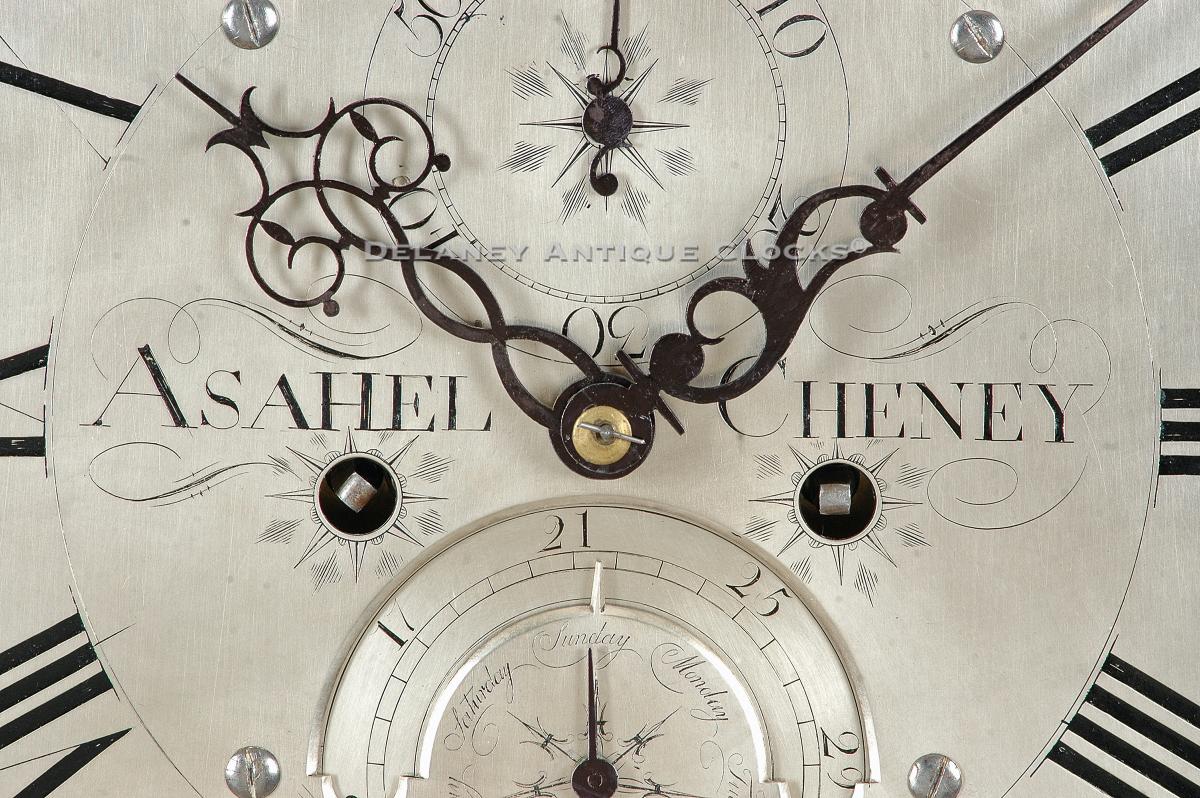Asahel Cheney of Hartford, Connecticut, Northfield, Massachusetts Putney, Windsor and Royalton, Vermont. A cherry case tall clock. 29107.
This is a signed Putney, Vermont Example.
Asahel Cheney was born in 1758 in East Hartford, Connecticut. He was the oldest son of the well-known Hartford, Connecticut clockmaker Benjamin Cheney and his wife, Deborah Olcott. Many examples of Benjamin's work have been recorded. A large number of them have movements constructed of heavy wooden gearing. Asahel and his brothers Elisha (B. 1770 - D.1847), Martin ( B. 1778 - ?), and Russell were all involved in clockmaking. A fine example of a tall case clock made by Asahel while in East Hartford can be found in the Mabel Brady Garvin Collection at Yale University. By 1790, Asahel had moved from Hartford to Northfield, Massachusetts, and is listed as a property owner. Here he continued to manufacture mostly tall clocks. We have owned several examples of his Northfield work. Both wooden and brass-geared examples of painted and engraved brass dials are known. By the mid-1790s, he had moved up the Connecticut River to Putney, Vermont, in Windham County. A shelf clock in the Henry Ford Museum collection is signed on the kidney-shaped engraved brass dial, "Asahel Cheney / Putney." A tall case clock that we once owned is also marked "Putney." It is pictured in The Best the Country Affords: Vermont Furniture 1765 -1850, which Kenneth Joel Zogry wrote. On the seat board of this clock, it is inscribed, "This clock was made by Martin Cheney." From this clock, we speculate that Asahel trained his brother Martin in the clockmaking trade, and they were working together at this time. Soon after 1800, the brothers parted company. By 1809, Asahel relocated North, and his name was listed in a land transaction in the town of Royalton.
This fine cherry case tall clock is well proportioned. The case stands on boldly formed ogee bracket feet. These are applied to the bottom of the double-stepped base molding. The waist is long and narrow and features a nicely shaped waist door that is trimmed with a simple molded edge. The bonnet is fitted with a traditional whale's tail fretwork pattern and three brass ball and spike finials. These are mounted on fluted finial plinths. The bonnet columns are free-standing and mounted in brass capitals. Tombstone shape side lights are cut into the side panels of the hood. These are fitted with glass. So is the arched bonnet door which opens to access the dial.
The sheet brass dial is skillfully engraved. This engraved dial form was very popular in the Connecticut valley region. This may be due to the clockmaking teachings of Thomas Harland and his apprentices. This includes Daniel Burnap of East Windsor, who is reported to have engraved dials for other Clockmakers. This dial is constructed from a thin sheet of brass. The decoration is skillfully engraved into the front surface. The engraving is then filled with wax, and a silver wash is applied to the dial. This dial features a traditionally formatted time ring. Roman-style numerals mark each of the twelve hours, and large Arabic numerals are used to mark each of the five-minute markers up to sixty. The nicely formatted steel hands indicate the time. A calendar aperture is located below the center arbor. Here the date of the month is indicated on a disk that is designed to rotate. Below this the day of the week calendar. Each day is fully written out or engraved in the script. The day is indicated by a separate hand. This type of calendar is a very unusual feature. A subsidiary seconds dial is located above the center arbor. The Clockmaker's name is boldly engraved in this central location. In the arch of this dial is a painted lunar calendar or moon phase dial. This rotates and is designed to track the lunar date. This dial is also decorated with long leafy vines, and florals are featured in the spandrels areas.
The time and strike movement is constructed in brass and designed to run for eight days on a full wind. It is good quality. It is weight-driven and will strike on a cast iron bell each hour. Please note the bulbous posts that support the plates.
This clock stands approximately 7 feet 7 inches tall and was made circa 1790.
Inventory number 29107.
Asahel Cheney was born about 1767 in East Hartford, Connecticut, and died in Royalton, Vermont, on October 31, 1819. He was the oldest son of the Hartford clockmaker Benjamin Cheney and Deborah Olcott. Many examples of Benjamin’s work have been recorded. A large number of them have movement constructed of heavy wooden gearing. Asahel and his two brothers, Martin and Russell, were most likely trained by their father. A clock that is in the Mabel Brady Garvin Collection at Yale University features an engraved brass dial and wooden geared movement that is signed, “Asahel Cheney / E. HARTFORD.” This clock is pictured in CONNECTICUT CLOCKMAKERS OF THE EIGHTEENTH CENTURY, written by Penrose R. Hoopes. By 1790, Asahel had moved to Northfield, Massachusetts, and was a property owner. He lived in what is now known as the Joseph Byrt house. Here he continued to manufacture mostly tall case clocks. We have owned several signed Northfield examples over the years featuring wooden and brass constructed movements. A second fine example can also be found in the Mabel Brady Garvin Collection at Yale University. This second clock is signed “Northfield.”
By the mid-1790s, Asahel moved to Windham County, Vermont, to the town of Putney. A shelf clock in the Henry Ford Museum collection is signed on the engraved brass kidney-shaped dial, “Asahel Cheney / Putney.” From this clock, we speculate that Asahel trained his brother Martin in the clockmaking trade. On the seat board of this clock, it is inscribed, “This clock was made by Martin Cheney.”
Soon after 1800, the brothers parted company. In 1806, Asahel moved to Royalton, VT, and purchased a store with Mr. Fessenden. He sells out his share and moves to Rochester only to return to Royalton. His name is listed in a land transaction in the town of Royalton, Vermont, in November of 1809. He purchased a shop and some land located near the Hotel from David Waller. In Royalton, he is reported to have had the clockmaker Jacob Kimball working with him. In 1818, he purchased the Gilbert Tavern. He died suddenly of apoplexy. He had a Masonic Funeral.


